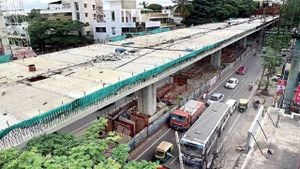Public transportation across Italy faced significant disruptions on February 24, 2025, as the Union of Base Workers (USB) organized a nationwide strike. Starting at 3:01 AM and concluding at the same hour on February 25, the strike impacted bus, metro, and tram services from major cities like Milan to Rome, and especially Naples.
Transportation company ANM announced limited services during the strike. While certain lines were guaranteed, others faced reduced availability, affecting thousands of daily commuters. For example, surface lines including trams and buses had services running only during specific hours: from 5:30 AM to 8:30 AM and then again from 5 PM to 8 PM.
Notably, the metro lines 1 and 6, which are pivotal for many residents, maintained full service according to early reports. The funicular services at Mergellina, Chiaia, Centrale, and Montesanto were also operational. "We’ve made sure to minimize inconvenience for our users wherever possible," stated ANM management. According to reports by the media, the adherence to the strike was initially low, as at 9:45 AM, the participation rate had not exceeded 9.2%, significantly alleviating service disruptions.
The USB called for the strike aiming to address significant worker concerns. Top on their list was the demand for enhanced safety measures, which include proper maintenance of trains and buses, increased surveillance with more cameras, and the incorporation of secure emergency stations. Union representatives emphasized the urgency for an increase in monthly wages by at least 300 euros to align with living costs and improving service standards. “Our members deserve fair compensation and safe working conditions,” remarked Lisa Rossi, USB spokesperson, during one of her public statements reported by local news outlets.
During the strike, the situation around cycling and walking paths also gained attention, as many commuters sought alternative means. This led to increased informal bike rentals and more people taking to the streets during peak hours. The response from local government officials highlighted the need to invest more significantly in sustainable transport options, especially during such labor actions. Local officials plan to review the efficiency and sustainability of transportation methods post-strike to mitigate future disruptions.
For those relying on the Circumvesuviana lines and other services headed to less central areas, very structured schedules were provided. Key journeys were maintained between 5:30 AM and 8:30 AM, with similar hours set for the evenings. For many, these arrangements provided some assurance, albeit needing flexibilities due to possible variations caused by worker participation.
The USB underlined this strike as part of broader discussions happening regionally and nationally concerning labor rights and safety, especially as economic challenges continue to strain household incomes across Italy. They are urging both local and federal governments to listen carefully to the voices of their workers who provide the backbone of public transportation.
Despite some relief from the strike’s impact, travelers endured lengthy wait times, particularly during morning hours as schedules adjusted to strike measures. Yet, the ANM laid out plans for immediate communication during the duration of the strike, ensuring passengers could access up-to-date information. Updates were communicated through social media and public announcement systems at stops.
Even as the chaos of the strike unfolded, it served as a spotlight on pre-existing issues within public transport systems. Various advocates highlighted the necessity for continuous improvement over the long-term crisis to prevent such extensive disruptions in the future. For some, the struggle for continual service improvements appears far from over.
Passengers affected by the strike had mixed reactions. Observers noted frustration, especially among regular commuters whose routines are heavily dependent on public transit. “We need transportation to work,” lamented Giovanni, a local coffee shop employee, citing how his schedules became more chaotic. “Every time there’s news of a strike, I get anxious about how to make it to the shop on time.”
The experience of ordinary passengers sheds light on the larger narrative about labor rights and the relate measurable impact of strikes on daily life. This strike, woven with challenges academia and local authorities, raises questions about public policy reforms needed to address labor demands, efficiency, accountability, and sustainable transportation options.
Following the strike's conclusion, attention is expected to shift back to discussions around the union’s demands and potential negotiations with transport authorities. The USB has made it clear they expect serious dialogues to improve working conditions and service reliability over the coming weeks as communities hope for more stable public transportation systems.



